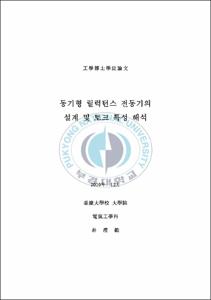동기형 릴럭턴스 전동기의 설계 및 토크 특성 해석
- Alternative Title
- Design and Torque Characteristics Analysis of Synchronous Reluctance Motor
- Abstract
- 본 논문에서는 동기형 릴럭턴스 전동기의 토크리플을 최소화하기 위한 회전자의 최적화 설계와 Winding Function Theory를 이용한 토크 특성 해석에 대하여 서술하였다.
Ld, Lq 차와 비의 특성을 이용하여 동기형 릴럭턴스 전동기의 토크 리플을 최소화 할 수 있는 회전자 자속 장벽의 개수를 유한요소 해석으로부터 결정하였다. 그리고 최적화 기법 중 크리깅을 토크 리플을 최소화 할 수 있는 회전자의 형상을 설계하였고 최적화 후의 토크 리플의 크기가 최적화 전의 토크 리플보다 70% 정도 줄어든 것을 확인하였다.
Winding Function Theory를 이용한 동기형 릴럭턴스 전동기의 토크 특성 해석을 위하여 회전자의 자속 경로를 계산할 수 있는 새로운 등가 모델을 제시하였다. 제시한 등가 모델을 이용하여 최적화 전 모델과 최적화 후 모델에 대한 토크 특성을 해석하고 유한요소해석을 통한 해석 결과와 비교 검토하여 타당성을 확인하였다. 또한 최적화한 동기형 릴럭턴스 전동기를 제작하고 구동 회로를 이용한 드라이브를 구성하여 토크 리플을 측정한 결과로부터 해석의 정확성도 확인하였다.
This paper describes on the design and torque characteristics analysis of synchronous reluctance motor with cylindrical rotor type. By using the difference and ratio between Ld and Lq the number of flux barrier to minimize the torque ripple was decided by finite element analysis. Kriging method was used to optimize the rotor shape and it was known that the amplitude of torque ripple was decreased to 70%.
Winding function theory was used to analyze the torque characteristics of synchronous reluctance motor. In winding function theory, the calculation of inductances is very important. To compute the self and mutual inductances of synchronous reluctance motor, new equivalent rotor model was proposed because of calculation difficulty of inductances of synchronous reluctance motor with cylindrical rotor type. The analysis results by winding function theory was compared with those of finite element analysis. From this comparison the proposed equivalent rotor model was proved. The experimental results also show the validation of proposed model.
- Issued Date
- 2011
- Awarded Date
- 2011. 2
- Type
- Dissertation
- Keyword
- windingfunction 동기형 릴럭턴스 전동기
- Publisher
- 부경대학교
- Affiliation
- 부경대학교 대학원
- Department
- 대학원 전기공학과
- Advisor
- 박한석
- Table Of Contents
- 제1장 서 론 1
1.1 연구배경 및 필요성 1
1.2 연구내용 3
제2장 동기형 릴럭턴스 전동기 5
2.1 기본 원리 5
2.2 D-q 전압 및 토크 특성 7
2.3 최대 역률 특성 9
2.4 회전자 설계 11
2.4.1 기본모델과 재 설계시 고려사항 11
2.4.2 토크 및 역률 특성에 영향을 미치는 설계변수 12
2.4.3 회전자 설계 과정 및 개선 방안 15
제3장 Winding Function 이론 16
3.1 원통형 회전기에 대한 winding function 이론 16
3.2 돌극형 회전기에 대한 winding function 이론 22
3.3 인덕턴스 계산 26
제4장 유한요소 해석 수식 정식화 30
4.1 유한요소 해석 30
4.1.1 유한요소법 32
4.1.2 지배방정식 유도 33
4.1.3 Galerkin법에 의한 정식화 36
4.1.4 회로방정식과 전자계 방정식의 결합 42
4.1.5 추력 및 수직력 계산 46
제5장 회전자 형상 설계 49
5.1 유한요소법에 의한 특성 해석 49
5.1.1 설계 변수에 따른 특성 해석 49
5.1.2 개선 모델의 특성 해석 60
5.2 최적화 기법에 의한 회전자 형상 설계 62
5.2.1 크리깅 방법 62
5.2.2 단순 크리깅 63
5.2.3 정규 크리깅 66
5.2.4 공동 크리깅 69
5.2.5 일반 크리깅 71
5.3 회전자 최적 설계 73
5.3.1 Sample model 75
5.3.2 최적 설계 76
제6장 토크 특성 해석 80
6.1 동기형 릴럭턴스 전동기 사양 80
6.2 Winding Function 80
6.3 토크 특성 83
제7장 구동 시스템 구성 및 실험 96
7.1 실험 장치 구성 96
7.1.1 DSP를 이용한 메인 보드 97
7.1.2 전력 변환 회로 100
7.2 실험 장치 구성 102
7.3 실험 결과 고찰 103
제8장 결 론 105
참고문헌 107
Abstract 112
- Degree
- Doctor
- Files in This Item:
-
-
Download
 동기형 릴럭턴스 전동기의 설계 및 토크 특성 해석.pdf
기타 데이터 / 5.54 MB / Adobe PDF
동기형 릴럭턴스 전동기의 설계 및 토크 특성 해석.pdf
기타 데이터 / 5.54 MB / Adobe PDF
-
Items in Repository are protected by copyright, with all rights reserved, unless otherwise indicated.